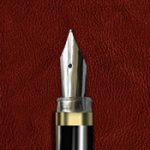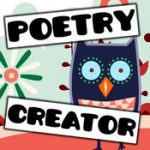How to run a creative workshop based on Lord Byron’s Ink Stand
Artwork by , created in
About this activity
Workshop themes
- Ink
- Poetry
- Typography
- Words
Suitability
- Suitable for groups
- Suitable for one to one
Difficulty level
Medium

Skip to section
Introductions
Materials
- Name badges (for all participants and staff).
Method
- Go around the room and make eye contact with everyone, shake their hand and say hello.
- Write the start of a question for everyone to see (i.e. my favourite job was, my hobby is…) and go around the room with each person finishing the sentence. When the group completes this task, post another question and start again.
- The questions could be imaginative and not based on true answers. Let the group know this and the answers, therefore, can be humorous, exploring the depth of people’s imaginations!
- You could link the sentences to famous pieces of poetry or rhymes. These exercises will give context to the theme of Byron and his poetry.
TimeSlips™
Materials
- Flipchat and pen
- An image of the artwork (can be viewed in the app or printed from this link )
Method
- Look at the artwork using the Armchair Gallery app.
- Welcome and invite the person or group to create with you and write their answers on the flip chart. Ask open-ended questions (like in the list to the right).
- Affirm/echo all their answers - together we build a story that can have sound, movement, words - even drawings.
- Retell the story, then invite them to add another creative element like sound, or movement.
Suggested Questions
- What is going on in the picture?
- What is this used for?
- What do you think it is made from?
- What details can you see on the inkstand?
- Who do you think used this inkstand?
- Do you know of any famous poets?
- Do you know of any well-known poems or tongue twisters?
- Do you know of any well-known actors or actresses?
- Who would you like to write a letter to?
Play this video
Workshop members can watch this on their own tablet, or you can play it to the group by connecting your tablet to a TV or projector. It can also be downloaded from the Armchair Gallery website.
Interact with the artwork
At this point in the workshop participants should have a go at using the app to interact with the artwork. From the main menu, enter Newstead Abbey, select Lord Byron’s Ink Stand and tap Interact and play.
Multi-Sensory Exploration, Part 1
Materials
- Laptop or iPad and speaker for sounds.
- Edible rice paper.
- Edible ink or icing tubes.
- Amethyst/brass metal.
- Feathers.
- Ink (an assortment of colours).
- Lining wallpaper and masking tape to secure.
- Pipettes.
- Straws.
- Writing paper.
- Fountain pens.
- Envelopes.
- Brasso.
Sound
- Download some of Byron’s poetry including She Walks in Beauty and We’ll go no more a Roving.
- Byron’s poetry can be explored further by using a simple call and response method with participants. The facilitator says one line at a time for the group then to repeat. The whole poem can be read like this or just a verse from a poem.
Multi-Sensory Exploration, Part 2
Taste
- Use edible rice paper and icing to create pieces of simple words and poetry with participants. When written, they can be passed to another participant to read and then the poems can be eaten!
- You can find edible sheets of paper in most old sweet shops or buy them online.
- If people are struggling with squeezing the icing tubes you can also purchase edible ink.
Touch
- Pass people some amethyst and brass to touch, exploring their different qualities. Byron’s Ink Stand is made from these materials.
- Pass participants some large feathers and ink. Enjoy using the old method of writing using the feather dipped in ink!
Multi-Sensory Exploration, Part 3
Sight
- Roll out some backing paper onto a large table and secure this down with tape. Using pipettes, create various droplets of coloured ink on the table and use straws to blow the ink to make patterns on the paper. Create a group ink painting.
- Ask people to find letters that have naturally formed from blowing the ink around the paper. Can they make a word with the letters you find?
- Byron loved writing letters. Hand out some writing paper addressed to the various members of your group. Ask your group to write or draw a message to someone else in the group. Ask them to put them into envelopes and then deliver these to whom they are addressed.
- Alternatively, you could collect all of the letters and then post these through everyone’s personal letterboxes at the end of the workshop or the next day.
Smell
- Pass around Brasso and clean the brass that you passed around earlier. The scent of Brasso is very distinctive and may prompt discussions relating to the memory of the smell.
Making: Theatre Mask
Making: Theatre Mask
The origins of the Tragedy and Comedy masks can be traced back to open-air Greek theatre. Greek plays were performed wearing them and they represented different emotions in order for the audience to distinguish between them.
This task will give participants the opportunity to design their own theatrical mask. Lord Byron loved the theatre and the varying emotions it portrayed. This activity will promote conversations around what each mask depicts, either Tragedy or Comedy.
Materials
- You've done this wrong templates.
- Card (an assortment of colours).
- Decorations for masks including Byron’s poems, textiles such as lace, feathers, gems and felt tip pens.
- Glue and glue sticks.
- Sticks.
- iPad – camera and photobooth.
Method
- Choose a variety of decorative mediums that you would like to use on the mask. This could include paint, sequins and lace, or anything you can find!
- Begin by building up layers of colour onto the mask. This will create a base for everything else. Paintbrushes or other tools can be used to do this, such as cotton buds and stamps.
- Continue to add other textures and decorations to the mask. There is no right or wrong way of doing this. Creativity is to be encouraged!
- Leave the mask/s to dry overnight.
- Printed excerpts of Byron’s poetry can be used to decorate the masks.
- These masks can be used for other themed sessions, including going to a ball or an evening event or theatre inspired workshop.
Celebration
Ask participants to pose for photos wearing their masks. Print the photographs out and hand them out immediately or print later to give to people next time.
Conclude by giving the group a big round of applause and thank them for all attending and contributing to the group.
Finally…
Getting Materials
You should be able to get most of the materials mentioned in this guide at your local arts supplier.
They are also avaiable on Amazon. If you shop via Amazon Smile (using the button below - UK only), then we will recieve a donation that we can put towards our work with older people.
Other Apps
You could use these other apps to further explore digital technology in your workshop.



